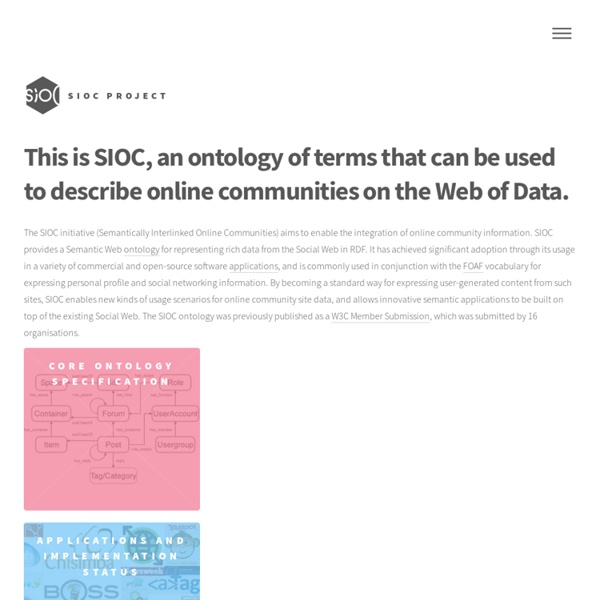



SKOS Simple Knowledge Organization System - home page SKOS is an area of work developing specifications and standards to support the use of knowledge organization systems (KOS) such as thesauri, classification schemes, subject heading lists and taxonomies within the framework of the Semantic Web ... [read more] Alignment between SKOS and new ISO 25964 thesaurus standard (2012-12-13) ISO 25964-1, published in 2011, replaced the previous thesaurus standards ISO 2788 and ISO 5964 (both now withdrawn). Members of the Working Group responsible for ISO 25964 have gone on to consider the implications for SKOS users. They have developed a set of linkages between the elements of the ISO 25964 data model and the ones from SKOS, SKOS-XL, and MADS/RDF. From Chaos, Order: SKOS Recommendation Helps Organize Knowledge (2009-08-18) Call for Review: SKOS Reference Proposed Recommendation (2009-06-15) The Semantic Web Deployment Working Group has published the Proposed Recommendation of SKOS Simple Knowledge Organization System Reference.
YAGO2 - D5: Databases and Information Systems (Max-Planck-Institut für Informatik) Overview YAGO is a huge semantic knowledge base, derived from Wikipedia WordNet and GeoNames. Currently, YAGO has knowledge of more than 10 million entities (like persons, organizations, cities, etc.) and contains more than 120 million facts about these entities. YAGO is special in several ways: The accuracy of YAGO has been manually evaluated, proving a confirmed accuracy of 95%. YAGO is developed jointly with the DBWeb group at Télécom ParisTech University.
Graphviz New Release 2.38 (13 April 2014) The dot program now supports packing of connected components the same way of the other layout tools. (7 March 2014) The edgepaint filter has been added to Graphviz. Given a graph that has been laid out, edgepaint colors the edges in a manner to make it easier for the viewer to distinguish edges that intersect in an almost parallel fashion. New Release 2.36 (11 January 2014) Public webdot server now available (20 August 2013) A public webdot server is available for use at . New Release 2.34 (6 September 2013) This release includes a new (1.5) version of the xdot format supporting inline text characteristics such as <b> and version-specific output based on xdotversion. New Release 2.32 (1 August 2013) This release includes the features noted below, plus there is a new (1.3) version of the xdot format that encodes linear and radial gradient as color values. New features (July 2013) Graphviz now supports the star node shape See here.
Top 100 most popular RDF namespace prefixes | cygri’s notes on web data I run prefix.cc, a website for RDF developers where anyone can register and look up the expansion URIs for namespace prefixes such as foaf, dc, qb or void. The site tracks which prefixes gets looked up most often. This allows some insight into the popularity of RDF vocabularies and datasets. This post is a snapshot of the top 100 most requested prefixes as of today. Caveats: The counts reflect what knowledgeable RDF hackers are interested in. That being said: The data is below, and a CSV version is available too.
Graph | UMBEL The core UMBEL ontology now contains about 26,000 reference concepts organized according to 33 super types. There are more than 60,000 relationships amongst these concepts, resulting in a graph structure of very large size. It is difficult to grasp this graph in the abstract. Thus, using methods earlier described in our use of the Gephi visualization software [1], we present below a dynamic, navigable rendering of this graph of UMBEL core: Note: at standard resolution, if this graph were to be rendered in actual size, it would be larger than 34 feet by 34 feet square at full zoom !!! This UMBEL graph displays: You may also want to inspect a static version of this big graph by downloading a PDF.
XML Editor, Data Management, UML, and Web Services Tools from Altova Bio2RDF: Linked Data for the Life Sciences DBpedia.fr A brief foray into vectorial semantics « the jsomers.net blog I designed my notes archive to be as easy to write to as possible, because I knew that if there were any friction in the process, I wouldn’t stick with it. So I purposely decided not to tag, label, file, or otherwise classify each note. The only bits of metadata I do have are timestamps and permalinks, both of which are generated automatically by Tumblr. The unfortunate side effect is that this “archive” of mine, more than two years in the making, is little more than a 280,000-word soup of fragments. Over the weekend, then, I decided to throw a little code at the problem—to see if I could perhaps automatically add structure to my archive. Step 1: Database-ify I should have fetched my notes and stored them in a local database a long time ago. So that’s what I did first, using the Tumblr API and this simple script. Step 2: Introducing tf-idf weights Amazon.com’s Statistically Improbable Phrases, or “SIPs”, are the most distinctive phrases in the text of books in the Search Inside! Vectors!
The Product Types Ontology: Use Wikipedia pages for describing products or services with GoodRelations